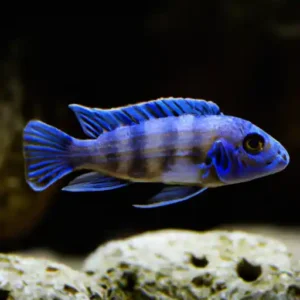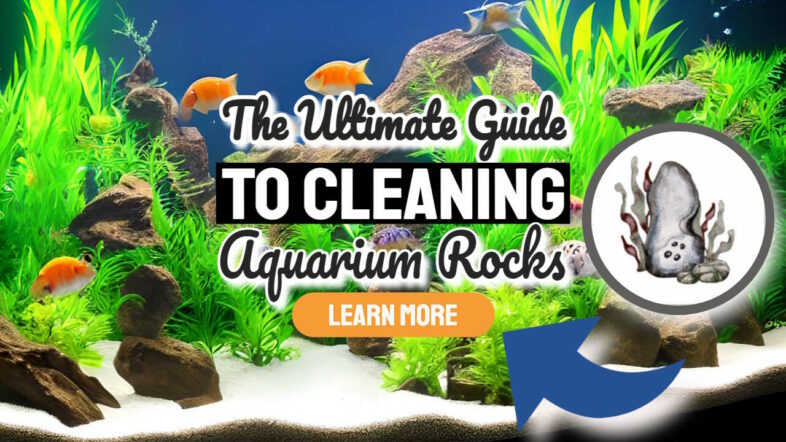Aquarium rocks are essential for creating a natural and visually appealing environment for fish and plants. However, they can also become a source of harmful bacteria, algae, and parasites if not cleaned regularly. Dirty rocks can lead to a variety of health issues for your aquatic pets, including fin rot, swim bladder disease, and even death in extreme cases.
The Importance of Cleaning Aquarium Rocks
Cleaning aquarium rocks is not only necessary for the health of your fish but also crucial for maintaining the overall cleanliness and clarity of your tank. Over time, debris and waste accumulate on the surface of rocks, leading to foul odour and unsightly buildup.
Potential Risks of Dirty Rocks to Fish and Plants
The accumulation of dirt and debris on aquarium rocks creates an environment conducive to harmful bacteria growth. This bacteria poses significant risks to the health of fish and plants present in the tank.
As fish swim through the water or nibble on nearby plants or algae that grow on dirty rocks, they can ingest potentially harmful pathogens. In addition to bacterial growth, dirty aquarium rocks can host parasitic organisms such as snails or worms that can harm your aquatic pets.
These parasites feed on organic matter trapped in crevices between stones or in cracks along their surfaces. Dirty aquarium rocks may also contribute to poor water quality by releasing high levels of ammonia into the water column as organic materials decompose over time.
High levels of ammonia create an unhealthy living environment for both fish and plants present in the tank. It is vital to clean aquarium rocks regularly because neglecting them could lead to various health risks affecting both aquatic life forms in the tank as well as negatively impacting overall cleanliness; it could eventually cause eventual death if left unchecked.

Training Instructions for Aquarium Rock Cleaning
Supplies You Will Need
Before diving into the process of cleaning aquarium rocks, it is essential to gather all the necessary supplies. Here's a list of items you'll need:
1. Bucket – Fill this with water that you will use to rinse off the rocks.
2. Scrubbing brush or toothbrush – Use a brush with soft bristles to scrub off any dirt or algae on the rocks.
3. Gravel siphon – This tool helps remove debris from the bottom of the tank while sucking out dirty water and replacing it with clean water.
4. Safety gloves – While cleaning aquarium rocks, it is crucial to wear rubber gloves to protect your hands from any harmful bacteria or chemicals that may be present.
How to Use Each Item
A bucket is essential to keep nearby while cleaning aquarium rocks as it will be used to hold clean water for rinsing each rock after scrubbing them clean. Without a bucket, you might have trouble keeping clean water nearby and could end up contaminating your workspace and making a bigger mess than necessary.
Using a scrubbing brush or toothbrush can help remove any stubborn dirt spots on your aquarium rocks without damaging them in any way. Soft-bristled brushes are recommended as they won't scratch or damage your rock's surfaces during the cleaning process but effectively remove grime and dirt buildup over time.
A gravel siphon is another critical tool because it removes debris from beneath your tank's gravel bed without disturbing live plants' root systems. A siphon also helps when removing old or dirty aquarium substrate as well as when changing out old gravel for new gravel if desired.
Safety gloves are crucial when handling chemicals during sanitizing processes such as using bleach since bleach can cause skin irritation if not handled correctly. Gloves can also help keep hands safe from sharp or jagged edges that may cause cuts or scrapes while cleaning rocks.
Removing Rocks from Aquarium
![]() Removing rocks from an aquarium can be a bit tricky, but it is crucial to ensure that you don't harm your fish or plants in the process. The first step is to carefully unplug any electrical equipment such as filters and heaters to prevent any accidents.
Removing rocks from an aquarium can be a bit tricky, but it is crucial to ensure that you don't harm your fish or plants in the process. The first step is to carefully unplug any electrical equipment such as filters and heaters to prevent any accidents.
Once you have done this, it's time to start removing the rocks. Begin by using a net to scoop out the rocks from the aquarium.
Make sure that you don't remove too many at once, as this can lead to an imbalance in the water chemistry and disturb your fish and plants. If there are any large rocks that cannot fit into the net, use your hands to gently lift them out of the water.
Be extremely careful not to drop any rocks back into the aquarium during this process. Dropping them can cause damage to the glass or acrylic walls of your tank, which could potentially harm your aquatic pets.
Tips on how to avoid disturbing fish or plants in the process
Removing rocks from an aquarium can be stressful for fish and other aquatic life. To minimize stress on your pets, try not to remove all of the rocks at once.
Instead, break up cleaning sessions into smaller increments over a few days or even weeks.
Another way not to disturb them is by creating hiding spaces for fish using large stones or PVC pipes temporarily placed in strategic corners while cleaning is ongoing.
It's also essential not only to clean existing tanks but also to quarantine new rock additions for at least two weeks before placing them inside an active tank setup where they may have bacteria or parasites harmful to fish's health.
When removing rocks, handle them with care so that you do not stir up sediment or debris that may cause water cloudiness or other issues with water quality.
Always wash your hands thoroughly before handling any equipment used in handling rock cleaning materials. By following these tips on safely removing rocks from an aquarium, you can ensure that your fish and plants stay healthy and happy during the cleaning process.
Scrubbing and Rinsing Rocks
Detail how to scrub and rinse rocks properly
Scrubbing and rinsing your aquarium rocks is an essential part of cleaning them. When scrubbing, use a soft-bristled brush or toothbrush to remove any visible debris, algae, or buildup from the rocks.
Be gentle when scrubbing to avoid damaging the rocks or removing beneficial bacteria that may be present. After scrubbing, it's important to rinse the rocks thoroughly with clean water.
This will help remove any leftover debris or cleaning solution from the rocks. Use a strainer or colander to catch any loose particles as you rinse.
Different methods for scrubbing aquarium rocks
There are different methods for scrubbing aquarium rocks depending on their size and shape. For large flat stones, you can use a scraper to remove algae and debris quickly.
For smaller stones, a soft-bristled brush or toothbrush works well. When using a toothbrush for scrubbing your aquarium rocks, choose one with soft bristles that won't scratch the surface of your rocks.
![]() You can also make your homemade cleaner by mixing equal parts water and vinegar in a spray bottle. Another method is using an aquarium-safe cleaning solution like API Algae Scraper for Glass Aquariums.
You can also make your homemade cleaner by mixing equal parts water and vinegar in a spray bottle. Another method is using an aquarium-safe cleaning solution like API Algae Scraper for Glass Aquariums.
This product comes with detachable handles so you can easily clean hard-to-reach areas underwater. Regardless of which method you choose, be sure to rinse your aquarium rock thoroughly after cleaning it to remove any traces of cleaning solution before returning it back into your tank.
Sanitizing Rocks
When it comes to cleaning aquarium rocks, scrubbing them with water and soap is not enough. Sanitizing is a crucial step in ensuring the health and safety of your fish and plants.
Sanitizing removes any harmful bacteria or parasites that might be living on the rocks, preventing diseases from spreading among the aquatic life in your tank.
Why Sanitizing Is Important
Dirty rocks can introduce harmful pathogens to your aquarium, which can quickly spread throughout the tank and infect your fish or plants. These pathogens can cause diseases such as fin rot, bacterial infections, or ich. In some cases, these diseases can be fatal for your fish or plant life.
Sanitizing aquarium rocks effectively kills off any harmful bacteria present on them and prevents further infections from occurring. It's important to sanitize new rocks before adding them to your aquarium as well because they may contain harmful bacteria that could harm your existing aquatic life.
Different Aquarium Rock Sanitizing Methods
There are different ways you can sanitize aquarium rocks depending on what you have on hand. One effective method is using bleach diluted with water. You'll want to use a 1:20 ratio of bleach to water (roughly one cup of bleach per gallon of water).
Soak the rock in this solution for about 15 minutes before rinsing thoroughly with clean water. If you don't want to use bleach, another sanitizing option is hydrogen peroxide.
Mix equal parts hydrogen peroxide and water in a bucket or container big enough for the rock you want to sanitize. Allow the rock to soak in this solution for about 20 minutes before rinsing thoroughly with clean water.
No matter which method you choose, always make sure to rinse off the rocks thoroughly after sanitizing them to ensure no harmful chemicals are left behind. And once the rocks have been sanitized and rinsed, you can let them air dry before returning them to your aquarium.
Drying and Replacing Rocks
How to dry rocks properly before replacing them in the aquarium
![]()
Once you've finished scrubbing and sanitizing your aquarium rocks, it's important to let them dry completely before returning them to the tank. Damp rocks can cause unwanted bacteria growth and algae blooms, which can harm your fish and aquatic plants. To ensure that your cleaned aquarium rocks are completely dry, spread them out on a clean towel or paper towel and let them air-dry for 24-48 hours in a well-ventilated area.
If you need to speed up the drying process, consider using a fan or hair dryer set on low heat. Avoid using high heat settings as they can damage your rocks.
Once dry, inspect each rock carefully to make sure there is no moisture remaining. It's also important to make sure that all cleaning supplies have been removed before placing the rocks back into the tank.
Proper placement of clean rocks in the tank
Before adding clean aquarium rocks back into your tank, it's essential to consider their placement carefully. Landscape design is an essential part of maintaining an aesthetically pleasing aquarium while keeping fish healthy and happy.
Make sure each rock is arranged securely so that it won't shift or fall over time. Distribute larger boulders throughout the tank so that they do not create an imbalance in one area by causing too much weight on one side of the aquarium floor or another.
It's also important not to overcrowd the tank with too many rocks as this can lead to poor water circulation, blocked filters or stagnant areas where waste builds up faster than it can be dispersed by current flow. Double-check that no sharp edges are exposed once you have placed each rock carefully inside its new location within your beautiful aquarium scene!
Maintenance Tips
Regular Cleaning
Once you have successfully cleaned your aquarium rocks, the next step is to establish a regular cleaning schedule. The frequency of cleaning depends on the size of the tank and the number of fish.
A general guideline is to clean larger tanks less frequently than smaller ones, but it also depends on how many fish are in the tank. For example, a 10-gallon tank with one or two small fish should be cleaned once every two weeks, while a 50-gallon tank with several larger fish may need weekly or biweekly cleanings.
Preventing Algae Growth
One of the best ways to maintain clean aquarium rocks is to prevent algae growth in your tank. The algae growth can cause discolouration and unpleasant odours in your aquarium.
To prevent algae growth, make sure you do not overfeed your fish as uneaten food can contribute to its growth. You can also control light exposure by keeping your aquarium away from direct sunlight and by minimizing artificial light exposure during certain times of day.
Cleaning Filter Media
In addition to cleaning your aquarium rocks regularly, it’s important to maintain other parts of your aquarium too. One crucial aspect is cleaning filter media regularly since it traps debris from your aquarium water and prevents it from recirculating back into the water column.
How often you need to clean depends on what type of filter media you use as some varieties require more maintenance than others. By following these maintenance tips, not only will you keep your rocks looking beautiful for years to come but also provide an optimal environment for healthy aquatic life.
If you need a good aquarium heater you may like our article reviewing the AQQA Quartz heater.
Conclusion
Summary of Key Points
Cleaning aquarium rocks is an essential part of maintaining a healthy aquatic environment. It helps to prevent the build-up of harmful bacteria and excess waste that can harm fish and plants.
In this article, we have covered the necessary supplies needed for cleaning aquarium rocks, the proper methods for scrubbing and sanitizing rocks, as well as tips on drying and replacing them in the tank. By following these steps regularly, you can ensure that your aquarium rocks remain clean and healthy for your aquatic life.
The Importance of Clean Aquarium Rocks
 Keeping your aquarium clean ensures your fish's health and well-being and enhances their vibrant colours and beauty.
Keeping your aquarium clean ensures your fish's health and well-being and enhances their vibrant colours and beauty.
When rocks are dirty or covered in algae, it can negatively impact water quality by releasing harmful chemicals into the water that can harm your fish or plants. Clean rocks help prevent disease outbreaks in fish by reducing stress on their immune systems.
An Optimistic Spin on Clean Rocks
Remember that having a clean aquarium with healthy aquatic life is not only beneficial for them but also therapeutic for us as humans. Watching fish swim around in a clean tank has been shown to have a calming effect on people, reducing stress levels while increasing relaxation and enjoyment.
So take pride in keeping your aquarium rocks sparkling clean because not only are you providing a safe home for your aquatic pets but you are also creating an oasis of peace within your home's walls! For more information visit: https://aquariumrocks.net/
A Guide to Installing Safety Rails in Family Treehouses
Installing safety rails on a family treehouse requires compliance with local safety guidelines. Essential steps include using sturdy 4×4 posts secured with through-bolts and vertical balusters no more than 4 inches apart to prevent accidents and falls. This is just the beginning of ensuring treehouse safety…
Eheim Thermocontrol e200 Heater Review: Adjustable 200W Aquarium Heater
Welcome to our in-depth review of the Eheim Thermocontrol e200 Heater. If you're a fish enthusiast looking to maintain the perfect temperature in your aquarium, this heater might just be the solution you've been searching for. With its adjustable temperature settings, durable construction, and suitability for both freshwater and saltwater environments, the Eheim Thermocontrol e200 […]
AQQA Aquarium Heater Review: Intelligent External Controller for Precise Temperature Control
Dec 15, 2024 @ 18:42 Contents Introduction Product Description Pros and Cons Customer Reviews Conclusion FAQ Welcome to our in-depth review of the AQQA Aquarium Heater, a cutting-edge solution for maintaining optimal water temperature in your fish tank. This product, with its double quartz tube design and intelligent external controller, offers a range of features […]
What is Biogas?
The answer to the question, what is biogas? This environmentally friendly fuel is derived from anaerobic digestion (without oxygen). This process occurs in the presence of organic matter. In some environments, this organic matter is disposed of as livestock waste. In other locations, it is a waste water. There are many benefits of biogas for […]








